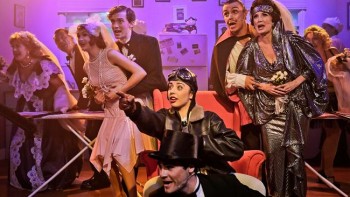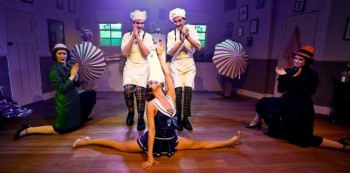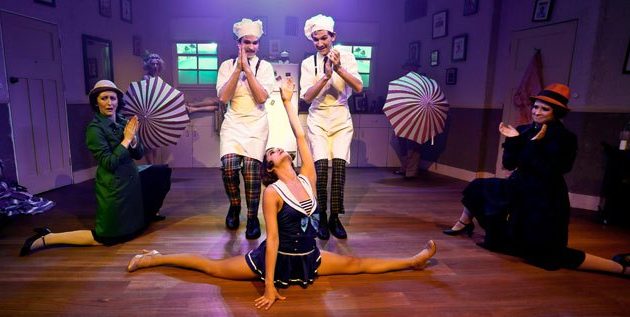The Drowsy Chaperone, Hayes Theatre
The Drowsy Chaperone, a loving parody of 1920s musicals and a thank you to musical theatre for making life a little more bearable, is something of a recent classic. It has played Broadway and the West End, it’s won several awards, and it’s now so beloved that it’s slated to be adapted for film, with our own Geoffrey Rush playing the Man in Chair. But it’s never felt sweeter or more necessary than it does now, in Sydney’s own Hayes Theatre.
Tucking The Drowsy Chaperone, a show entirely constructed around the concept of a 1920s musical bursting to full and glorious life inside a New York apartment, into the cozy Hayes Theatre, might seem like a daunting feat. The Aviatrix’s plane isn’t about to fit on the Hayes stage. Blessedly, though, the show fits perfectly – in some ways even reinforcing the magic that lies behind its initial conceit of simply imagining a record to life. Everything is elegantly slipshod, conjured from thin air and mundane life: the characters fly that aforementioned plane with broom propellers and ironing boards, re-purposing Man in Chair’s framed art for in-the-air ambience. It’s a clever way to resolve the immediate staging issue, and it works.

The Drowsy Chaperone hinges on that gift musicals have to spirit you away from your surroundings to somewhere a little better, nicer, or at least easier to bear. Where things work out: where phones don’t ring to shatter your solitude, where the couple always reunites, where love is real and felt with (eventual) clarity. There’s something sad about the show, but gently so: Man in Chair is alone, and has been, in his past, a little lost, and he craves his memories of childhood simplicity that have since been locked like a time capsule into his records. All he wants is to get that feeling back for a minute. And he does, more or less, and he talks us through it, and it’s a pure delight.
There’s plenty of wry commentary peppered through the show that turns it all into a splendid piece of meta-narrative. Just as Man in Chair talks about the shine of this old show and laments the latest commercialised offerings by Elton John and Disney, so too are we experiencing a new boutique musical in a new space that is specifically a retreat from the bigger theatres and flashier, arguably a little more soulless event musicals. The Hayes theatre is our tiny apartment littered with playbills; we all are Man in Chair, and and it all collides into the most delightful catharsis; this show understands where it is, who it is, and who we are, too, in the audience.
Geoffrey Rush might soon be the world’s Man in Chair, but Sydney might never feel for him what we feel for Jay James-Moody, who keeps his largely Chair-bound two hour performance alive with energy, with wonder and a little pain, wide-eyed and attentive and reminscing and experiencing; it’s a completely immersive performance from a man who acts with his heart. James-Moody wears his character in his whole body, with a shock of unbrushed hair and shuffling steps that melt into sprawled regality on his Chair, his throne, where James-Moody sits lived in and comfortable; indeed, one gets the sense that this is the only place where Man in Chair ever feels comfortable at all.
All the more impressive is that James-Moody also directed this show; the amount of work he has put into this show is as loving as could be, and that is so palpable when the lights come up and the show begins. Everyone has put everything they have into this one piece of theatre.

And if we weren’t lucky enough with Jay James-Moody, we also have Hilary Cole. She burned down all our defenses as the shy-turned-raging eponymous Carrie in Squabbalogic’s last outing, and who can blame Squabbalogic for not letting her go? We finally have a new ingenue, and it’s wonderful in The Drowsy Chaperone to see Cole play that part as starlet Janet van de Graaf, who is all glamour and humor and a complete tonal change from her debut. There’s a real playful humour to Cole’s Janet, who is about to leave her showgirl career behind for marriage. In her “Show Off” number, Cole is vivacious and very funny, but retains, most impressively, her pure lyric tone that soars above everyone else’s, almost breathtakingly, and then comes down and beckons you in closer for more, so she can share a secret. She has that elusive star quality as Janet and as herself, and she is one of the most exciting new talents to emerged in Sydney musical theatre in the past few years.
Janet is watched over by a “drowsy” (read: drunk) Chaperone, and in this role Michele Lansdown is droll, seductive, and at least one thousand per cent world weary; there isn’t much more pleasurable than an anthem in the classical musical theatre style, and Lansdown delivers it with ease and grace. She is a strong, anchoring presence next to Tom Sharah’s intentionally scenery-chewing Latin lover Aldolpho (Sharah fits so beautifully into independent music theatre; let’s hope he, his rock inflection, and his fearlessness, doesn’t go too far away).
Jamie Leigh Johnson’s Kitty, full of ambition but not so much with brains, is a bubbly confection that settles right into the 1920’s, much like Ross Chisari as best man George, who was possibly found in the 20’s and cast after being brought back to life. Vaudevillesque bakers/gangsters played by Steven Kreamer and Richard Woodhouse are also standouts.
Choreographed by Monique Salle, who is one of the best choreographers in the Sydney scene – she seems to intuit the best way to represent a show’s core aesthetic in a body and then coax it out (and she also played Trix, the Aviatrix), the movement is a well-crafted homage to the 1920’s, with taps and high kicks both, but by far and away her most impressive work comes in a number that sees groom Robert (Brett O’Neill) blindfolded and rollerskating, singing about being an “Accident Waiting to Happen.”
The beauty of Hayes Theatre Co is that it transports such a tiny space into such an infinite world of possibility; it is a true testament to and home for the versaitility and adaptability of musical theatre. This show couldn’t be further from the raw dirty-red raucousness of Sweet Charity, and The Drowsy Chaperone is all the better for it: it weaves a new tale into Sydney theatre history.
Melbourne might have had this show first, but for us it’s a statement, part of a new, fledgling musical theatre zeitgest. We have the talent, we have the stage, we have, so far, excellent programming. We need to take care of Hayes Theatre Co, and Squabbalogic, because with shows as warm and marvelous as The Drowsy Chaperone, they are taking care of us.


